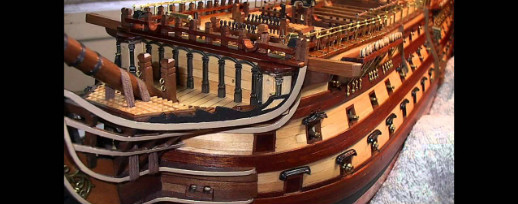
SANTA MARIA
| Product no.: | AD14 |
| List Price: | |
| Your price: | $399.00 |
| You save: | $300.00 (42%) |
| No. items in stock: | 5 |
| Availability: | In stock |
- Weight: Package Weight: 2.500kg (5.51lb.)
Scale:1:50
Size:760mm*630mm*350mm
The Santa María was built in Pontevedra, Galicia, in Spain's north-west region.[2][3] The Santa María was probably a medium-sized nau (carrack), about 58 ft (17.7 m) long on deck, and according to Juan Escalante de Mendoza in 1575, the Santa Maria was "very little larger than 100 toneladas" (about 100 tons, or tuns) burthen, or burden,[4][5][6] and was used as theflagship for the expedition. The Santa María had a single deck and three masts.
The other ships of the Columbus expedition were the smaller caravel-type ships Santa Clara, remembered as La Niña ("The Girl"), and La Pinta ("The Painted"). All these ships were second-hand (if not third- or more) and were not intended for exploration. The Niña, Pinta, and the Santa María were modest-sized merchant vessels comparable in size to a modern cruising yacht. The exact measurements of length and width of the three ships have not survived, but good estimates of their burden capacity can be judged from contemporary anecdotes written down by one or more of Columbus's crew members, and contemporary Spanish and Portuguese shipwrecks from the late 15th and early 16th centuries which are comparable in size to that of the Santa Maria. These include the ballast piles and keel lengths of the Molasses Reef Wreck and Highborn Cay Wreck in the Bahamas. Both were caravel vessels 19 m (62 ft) in length overall, 12.6 m (41 ft) keel length and 5 to 5.7 m (16 to 19 ft) in width, and rated between 100 and 150 tons burden.[7] The Santa María, being Columbus' largest ship, was only about this size, and the Niña and Pinta were smaller, at only 50 to 75 tons burden and perhaps 15 to 18 meters (50 to 60 feet) on deck[4] (updated dimensional estimates are discussed below in the section entitled Replicas).
A Spanish vessel in those days was given an official religious name, but was generally known by a nickname, oftentimes a feminine form of either her master's patronymic, or of her home port. Bartolomé de Las Casas, a priest and historian who extensively chronicled Columbus' expeditions, never used the name Santa María in his writings, and instead called the ship La Capitana ("flagship") or La Nao. Columbus himself, in his detailed logs, only called it La Capitana.[8] Some[who?] claim that the ship was known to her sailors asMarigalante ("Gallant Maria"), but that nickname was given to the Santa María 's namesake replacement, used on Columbus's second voyage.

This superbly detailed ship model kit has been designed and researched using the latest information and technologies available, making the ship model kit very easy to build with no sacrifice to even the finest detail. Comes with easy to follow step by step instructions and drawings. The materials included in this ship model kit are only the very best available.
Santa Maria Ship Model Kits make extensive use of laser cutting for all the wood sheets. The fittings, parts and timbers are only the best available. The comprehensive plans and highly detail English instructions will assist you throughout the whole construction process. Victory Models are at the forefront of innovate ship model kit manufacturing producing some of the highest quality ship model kits available.
Packaging Details
Contact
modelshippinter.com
647-409-4016
Wellcome our Website
Ship Model building is a rewarding and creative hobby. Whether you’re building a ship model for the first time or you’re an experienced modeler, you’ll find a ship model kit here that will bring you many hours of enjoyment. We have high quality ship model kits that everyone can afford.
